Protecting Against Frozen Pipes in Cold Weather: Critical Strategies
Protecting Against Frozen Pipes in Cold Weather: Critical Strategies
Blog Article
Are you trying to locate related information involving How to prepare your home plumbing for winter weather?

Winter can ruin your pipes, specifically by freezing pipes. Right here's how to avoid it from taking place and what to do if it does.
Intro
As temperatures decrease, the risk of icy pipes boosts, possibly causing pricey repair work and water damages. Understanding just how to avoid icy pipes is crucial for property owners in cold environments.
Prevention Tips
Protecting prone pipelines
Cover pipes in insulation sleeves or utilize heat tape to secure them from freezing temperature levels. Focus on pipes in unheated or outside locations of the home.
Home heating strategies
Keep interior areas adequately heated, specifically locations with pipes. Open up closet doors to permit cozy air to flow around pipelines under sinks.
Just how to determine icy pipelines
Seek lowered water circulation from faucets, unusual odors or sounds from pipelines, and visible frost on exposed pipes.
Long-Term Solutions
Structural changes
Consider rerouting pipelines far from outside wall surfaces or unheated areas. Add added insulation to attics, cellars, and crawl spaces.
Updating insulation
Purchase premium insulation for pipes, attic rooms, and wall surfaces. Proper insulation assists maintain consistent temperature levels and minimizes the danger of frozen pipes.
Protecting Outside Pipes
Garden pipes and outside taps
Detach and drain pipes garden tubes before winter. Set up frost-proof spigots or cover outside taps with insulated caps.
Recognizing Frozen Pipes
What triggers pipelines to freeze?
Pipes ice up when subjected to temperature levels below 32 ° F (0 ° C) for prolonged durations. As water inside the pipelines ices up, it expands, putting pressure on the pipe walls and possibly creating them to rupture.
Dangers and problems
Icy pipelines can bring about water supply disruptions, residential property damages, and pricey fixings. Ruptured pipes can flood homes and cause comprehensive structural damages.
Signs of Frozen Pipes
Identifying icy pipelines early can avoid them from breaking.
What to Do If Your Pipes Freeze
Immediate actions to take
If you believe frozen pipelines, keep taps open up to ease stress as the ice thaws. Utilize a hairdryer or towels taken in warm water to thaw pipelines gradually.
Verdict
Preventing frozen pipes calls for aggressive measures and fast actions. By comprehending the causes, signs, and preventive measures, home owners can protect their plumbing throughout cold weather.
5 Ways to Prevent Frozen Pipes
Drain Outdoor Faucets and Disconnect Hoses
First, close the shut-off valve that controls the flow of water in the pipe to your outdoor faucet. Then, head outside to disconnect and drain your hose and open the outdoor faucet to allow the water to completely drain out of the line. Turn off the faucet when done. Finally, head back to the shut-off valve and drain the remaining water inside the pipe into a bucket or container. Additionally, if you have a home irrigation system, you should consider hiring an expert to clear the system of water each year.
Insulate Pipes
One of the best and most cost-effective methods for preventing frozen water pipes is to wrap your pipes with insulation. This is especially important for areas in your home that aren’t exposed to heat, such as an attic. We suggest using foam sleeves, which can typically be found at your local hardware store.
Keep Heat Running at 65
Your pipes are located inside your walls, and the temperature there is much colder than the rest of the house. To prevent your pipes from freezing, The Insurance Information Institute suggests that you keep your home heated to at least 65 degrees, even when traveling. You may want to invest in smart devices that can keep an eye on the temperature in your home while you’re away.
Leave Water Dripping
Moving water — even a small trickle — can prevent ice from forming inside your pipes. When freezing temps are imminent, start a drip of water from all faucets that serve exposed pipes. Leaving a few faucets running will also help relieve pressure inside the pipes and help prevent a rupture if the water inside freezes.
Open Cupboard Doors
Warm your kitchen and bathroom pipes by opening cupboards and vanities. You should also leave your interior doors ajar to help warm air circulate evenly throughout your home.

Do you enjoy more info about Preventing and dealing with frozen pipes? Write a remark down the page. We will be glad to listen to your feelings about this write-up. We are looking forward that you visit us again soon. Sharing is good. One never knows, you may be doing someone a favor. Thanks a lot for being here. Kindly check our blog back soon.
This Site Report this page